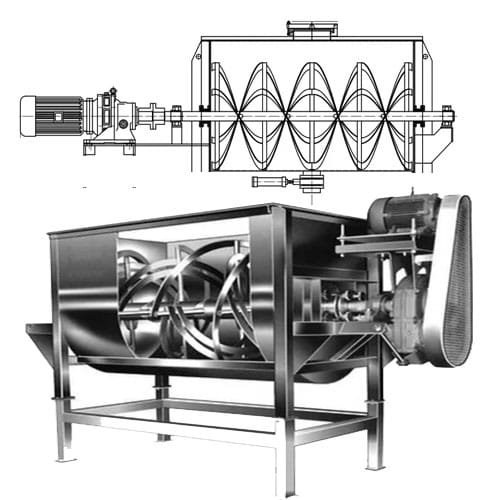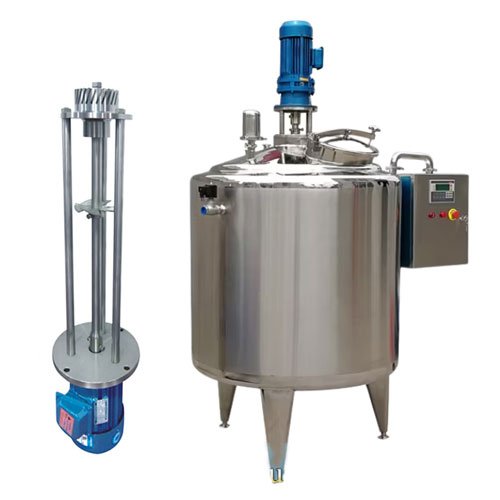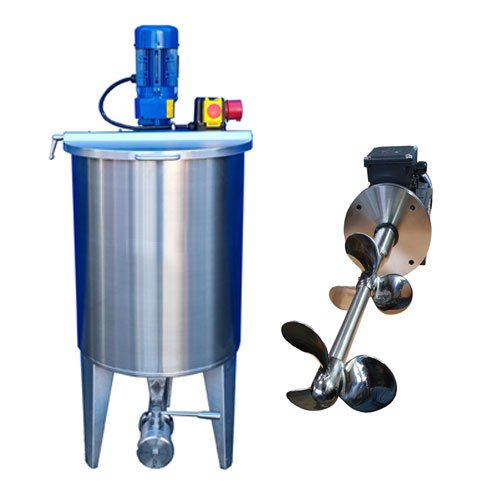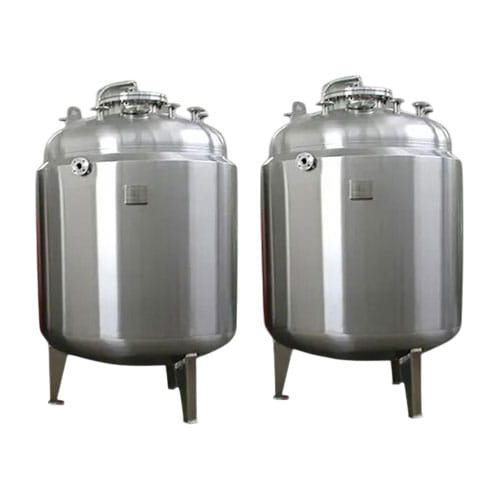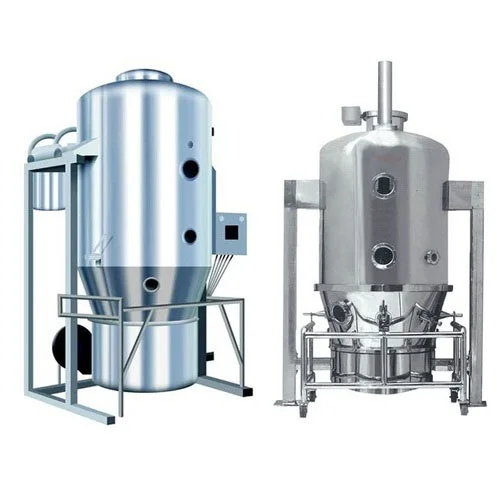What are Mixing Tanks or Mixing Vessels?
Mixing tanks and mixing vessels are crucial components in industries such as pharmaceuticals, food and beverage, chemicals, cosmetics, and water treatment. These vessels are designed to efficiently mix, blend, and homogenize liquids, powders, and semi-solids, ensuring consistency and quality in production processes.
Manufactured from high-grade stainless steel (SS 304, SS 316), mixing tanks offer excellent corrosion resistance, durability, and compliance with cGMP and FDA standards. They come in various sizes and configurations, including jacketed, insulated, and pressurized options, catering to diverse industrial needs. Some tanks feature agitators, propellers, or impellers to enhance mixing efficiency, while others incorporate heating or cooling mechanisms to maintain precise temperature control.
Mixing vessels are widely used in pharmaceutical production for drug formulation, in the food industry for blending ingredients, and in chemical processing for creating solutions and emulsions. Customizable features such as baffles, CIP/SIP (Clean-in-Place/Sterilize-in-Place) systems, and automated controls make them ideal for high-precision applications.
Investing in high-quality mixing tanks ensures improved productivity, reduced batch time, and enhanced product uniformity. Whether for small-scale R&D or large-scale manufacturing, selecting the right mixing vessel tailored to your process requirements is essential.
What are the components of Mixing Tank?

Tank mixers consist of several key components that work together to ensure efficient mixing, blending, or agitation of liquids. Here’s a breakdown of the main components:
Motor
The motor provides the necessary power to drive the impeller and mix the contents inside the tank. It can be electric, pneumatic, or hydraulic, depending on the application. The motor’s horsepower (HP) and speed (RPM) vary based on the viscosity and volume of the liquid being mixed.
Impeller
The impeller is the rotating component that generates fluid movement. Common impeller types include propellers, paddles, turbines, and anchor blades. The impeller design influences flow patterns, shear forces, and mixing efficiency.
Shaft
The shaft connects the motor to the impeller, transmitting rotational energy. It is usually made from stainless steel (SS304 or SS316) for corrosion resistance. The length and diameter of the shaft depend on the tank size and mixing requirements.
Seal
The seal prevents leakage where the shaft enters the tank. Types of seals include mechanical seals, lip seals, and packing glands. Proper sealing is essential for hygienic applications in food, pharmaceutical, and chemical industries.
Variable Frequency Drive (VFD)
A VFD controls the motor speed, allowing adjustable mixing intensity. It helps in energy savings, process control, and smooth startup. VFDs are useful when different mixing speeds are needed for various batch processes.
Exploring the Various Types of Tank Mixers

Each type of tank mixer serves a specific purpose based on the application, process requirements, and industry standards. Selecting the right mixer depends on factors such as fluid viscosity, volume, mixing intensity, and process conditions.
Top-Entry Mixers or Top Entry Agitators
Top-entry mixers are one of the most common types of tank mixers, mounted on the top of the tank with a shaft extending downward into the liquid. They are highly efficient for mixing large volumes and handling various viscosities, making them ideal for industries such as pharmaceuticals, chemicals, food, and wastewater treatment. These mixers use impellers to create a uniform mixture and can be customized with different impeller designs depending on the application.
Side-Entry Mixers
Side-entry mixers are mounted on the side of the tank and are used in applications where top-entry mixers may not be feasible due to space constraints or process requirements. These mixers are widely used in large storage tanks, such as those in the petroleum and beverage industries, to prevent sedimentation and ensure continuous movement of the liquid. They provide efficient mixing with lower energy consumption and are ideal for blending, maintaining uniformity, and preventing stratification.
Bottom-Entry Mixers or Bottom Entry Agitators
Bottom-entry mixers are installed at the bottom of the tank and are commonly used in industries where thorough mixing with minimal air entrainment is required. These mixers are particularly useful for high-viscosity liquids, emulsions, and shear-sensitive products such as creams, lotions, and pharmaceuticals. Bottom-entry mixers also facilitate easy tank emptying and cleaning, making them a preferred choice in hygienic applications.
Magnetic Mixers
Magnetic mixers use a magnetically driven impeller, eliminating the need for mechanical seals and reducing the risk of contamination. These mixers are widely used in pharmaceutical, biotechnology, and food processing industries where sterile and aseptic mixing is required. They are designed for easy cleaning and sterilization, making them ideal for processes that require high levels of hygiene and minimal maintenance.
Portable Mixers
Portable mixers are versatile and can be moved between different tanks, making them suitable for applications where flexibility is required. They can be clamped onto the side of a tank or mounted on a stand, allowing them to mix various liquid volumes and viscosities. These mixers are commonly used in small-scale production, pilot plants, and industries such as paints, chemicals, and food processing.
Static Mixers
Static mixers are non-moving devices installed inside a pipeline or tank to mix fluids as they pass through. These mixers rely on fixed internal elements to create turbulence and blend liquids efficiently without requiring a power source. They are commonly used in chemical processing, water treatment, and food industries for blending, emulsification, and reaction processes. Static mixers offer low maintenance and energy efficiency compared to mechanical mixers.
Jet Mixers
Jet mixers utilize high-velocity liquid jets to induce mixing within the tank. These mixers are particularly effective for blending, homogenization, and maintaining suspension in large storage tanks. Jet mixing systems are widely used in chemical, petroleum, and wastewater treatment industries where uniform distribution of solids and liquids is essential. They are energy-efficient and require minimal maintenance due to the absence of mechanical moving parts.
In-line Mixers
In-line mixers are designed for continuous mixing of liquids as they flow through a pipeline. These mixers are commonly used in industries such as pharmaceuticals, chemicals, and food processing for homogenization, emulsification, and dispersion. They provide consistent and controlled mixing without the need for large tanks, making them ideal for high-throughput production processes.
High Shear Mixers
High shear mixers are used for applications that require intense mixing, dispersion, and emulsification. These mixers operate at high speeds and generate strong shear forces to break down particles and create fine emulsions. They are commonly used in pharmaceutical, food, and cosmetics industries for processes such as creating creams, sauces, and suspensions. High shear mixers ensure uniform particle size distribution and improved product stability.
Applications of Mixing Tank
Mixing Tanks are essential components in industries requiring uniform blending, homogenization, suspension, or dissolution of materials. These mixers ensure that ingredients or raw materials are thoroughly combined to achieve consistency, quality, and efficiency in the production process. Mixing Tanks are integral to industries where precise and efficient mixing is required to maintain product quality, process efficiency, and regulatory compliance. By ensuring uniform dispersion of ingredients, these mixers contribute to the production of high-quality and consistent end products across various sectors.
Food and Beverage
Mixing Tanks are extensively used in the food and beverage industry to blend ingredients, maintain uniformity, and ensure proper emulsification. Common applications include:
- Beverage production: Mixing juices, carbonated drinks, dairy products, and alcoholic beverages.
- Sauces and condiments: Ensuring consistency in ketchup, mayonnaise, and dressings.
- Dairy processing: Homogenizing milk, cream, and yogurt.
- Bakery and confectionery: Mixing dough, syrups, and flavorings.
Chemical Processing
In chemical manufacturing, Mixing Tanks facilitate the proper blending of raw materials, stabilizers, and catalysts. Applications include:
- Resins and polymers: Ensuring uniformity in adhesives, paints, and coatings.
- Acid and alkali blending: Used in chemical reactions and neutralization processes.
- Detergent and cleaning products: Homogenizing liquid and powder-based formulations.
Pharmaceutical Manufacturing
Mixing Tanks play a crucial role in ensuring the precise formulation and uniform mixing of pharmaceutical products. Key applications include:
- Syrups and suspensions: Ensuring homogeneity in liquid medications.
- Tablet coating and granulation: Assisting in the uniform blending of active pharmaceutical ingredients (APIs).
- Creams and ointments: Achieving consistency in semi-solid pharmaceutical formulations.
Water Treatment
Mixing Tanks are used in water treatment facilities to ensure proper chemical dosing and distribution. Applications include:
- Coagulation and flocculation: Enhancing the removal of impurities from water.
- pH control and chemical dosing: Maintaining water quality by mixing disinfectants, pH adjusters, and coagulants.
- Sludge treatment: Assisting in the dewatering and digestion of sludge in wastewater treatment plants.
Cosmetics Manufacturing
The cosmetics industry relies on Mixing Tanks for precise blending of ingredients to achieve product consistency and stability. Applications include:
- Lotions and creams: Ensuring even distribution of active ingredients.
- Shampoos and conditioners: Achieving smooth, uniform emulsification of components.
- Fragrances and perfumes: Homogenizing essential oils and solvents for scent formulation.
Biotechnology
Biotech industries use Mixing Tanks for cell culture processing, fermentation, and enzyme production. Applications include:
- Bioreactors: Maintaining a controlled environment for cell growth.
- Enzyme and protein production: Ensuring even distribution of nutrients and reactants.
- Fermentation processes: Used in the production of biofuels, pharmaceuticals, and food additives.
Petrochemicals
Mixing Tanks are vital in the oil and gas industry for blending and maintaining the stability of fuel products. Applications include:
- Crude oil blending: Preventing sedimentation and ensuring uniform viscosity.
- Lubricants and additives: Mixing base oils and performance-enhancing additives.
- Asphalt production: Ensuring even dispersion of polymer additives in asphalt mixtures.
Mining
The mining industry relies on Mixing Tanks for mineral processing and slurry mixing. Applications include:
- Ore leaching: Mixing chemicals for metal extraction from ores.
- Flotation processes: Ensuring uniform distribution of air bubbles and reagents in mineral separation.
- Thickening and tailings treatment: Assisting in the dewatering of mining waste.
Pulp and Paper
Mixing Tanks are used in pulp and paper manufacturing for blending raw materials, chemicals, and additives. Applications include:
- Pulp preparation: Mixing wood pulp with chemicals for paper production.
- Coating formulations: Ensuring uniformity in paper coatings and finishes.
- Ink and dye mixing: Achieving consistency in printing inks and dyes.
Waste Management
Mixing Tanks contribute to environmental sustainability by aiding in waste treatment and recycling processes. Applications include:
- Sludge digestion: Enhancing biological degradation in wastewater treatment plants.
- Chemical neutralization: Mixing acids, bases, and other chemicals for waste treatment.
- Recycling processes: Assisting in the homogenization of waste materials before reprocessing.


